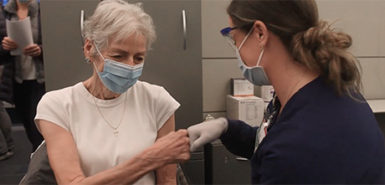Don’t let fears of COVID-19 stop you from seeking medical care for a stroke or heart attack.
That’s the message Spectrum Health heart and neurology specialists have for anyone experiencing symptoms of these life-threatening conditions.
“Hospitals are safe and prepared to take care of the whole gamut of medical problems,” said neurosurgeon Justin Singer, MD. “We go to great lengths to ensure our staff and our teams are safe and to provide a safe and clean environment for all patients.”
Unfortunately, doctors believe some people are postponing a trip to the hospital emergency department because they worry about the 2019 novel coronavirus.
“Some patients are arriving to our hospitals with signs that they have already had a stroke or heart attack,” Dr. Singer said. “When that happens, we are more limited in what we are able to do to try to reverse the problems and restore normal function.
“It is really important to save heart cells or brain cells to seek medical attention quickly.”
Prompt medical treatment can make a big difference in the long-term outcome for those suffering strokes.
“We always say, ‘Time is brain.’ For every minute the brain is deprived of blood, it loses millions of brain cells,” Dr. Singer said.
A patient who arrives at the hospital within 4½ hours of a stroke may be a candidate for the clot-busting drug, tPA.
If the doctors identify a blockage in a large brain artery, they may be able to perform a procedure to open the artery and restore blood flow.
Saving hearts
Quick medical care also makes a lifesaving difference for heart patients, said interventional cardiologist Ryan Madder, MD.
In March and April, Spectrum Health heart specialists noticed an increase in patients coming to the hospital late into their heart attack symptoms. That can have life-altering consequences.
“If you’re having a heart attack, the longer you wait to seek treatment, the higher your risk of mortality and the more damage will be done to your heart,” Dr. Madder said.
Delaying treatment can also lead to lower heart function after a heart attack and an increased risk of having congestive heart failure in the long term.
“Do not sit at home with chest pain,” he urged. “Please come in.”
Dr. Madder addressed a common misconception that a heart attack always causes severe pain in the chest. That is the case for some people. But other patients describe a feeling of pressure or heaviness in their chest.
“Oftentimes, a heart attack can cause very mild chest discomfort,” he said.
“It’s important for people to recognize if they feel any sensation in their chest that is new, they need to contact their physician. And if it’s an uncomfortable sensation, they need to call 911 or seek emergency treatment.”
The physicians reassured patients that the hospital screens employees every day, works hard to keep the hospital clean and keeps patients with COVID-19 separate from other patients.
“Be reassured we have taken the necessary steps as an organization to make sure our hospital is as safe as possible with respect to this COVID-19 infection,” Dr. Madder said.
“They should feel safe in going to the hospital,” Dr. Singer said. “They could put themselves at far greater risk if they don’t seek the help they need.”
COVID-19 risks for blood clots
Dr. Singer addressed reports that COVID-19 may be linked to blood clots and strokes.
“It appears there is a relationship between stroke and the presenting signs of COVID-19, especially in younger patients,” he said.
Doctors are still trying to determine how or why the two are connected.
“It relates to the inflammatory process of COVID-19,” he said. “It makes the blood more sticky and more prone to forming blood clots—and that is something we see in other inflammatory-type conditions.”
A discoloration in the toes—dubbed COVID toes—seen in some patients also may be a sign of blood vessel abnormalities caused by the disease, he said. The rash-like areas can resemble frostbite damage.
Sometimes patients describe a burning or tingling sensation or say their toes feel hot or cold.
“We are still getting a better understanding of what’s going on,” Dr. Singer said.
The discoloration may be caused by blood clots forming in micro blood vessels of the toes. The vessels may leak or rupture, Dr. Singer said.
The symptom is also seen with chronic conditions where people develop swelling in their legs.
If someone is experiencing that symptom, and other possible COVID-19 symptoms, he suggested consulting a health care provider.





 /a>
/a>
 /a>
/a>
 /a>
/a>